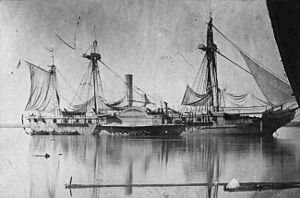 |
| USS Mississippi |
Lieutenant-General PEMBERTON:
HEADQUARTERS,
Port Hudson, La., March 14, 1863.
COLONEL: I have the honor to report that on Monday last, March 9, the enemy gave some indications of advancing, and on Tuesday moved out with considerable force of infantry, cavalry, and artillery on the three roads, but made a halt only a few miles from Baton Rouge. He moved a portion of his forces by transports about 5 miles above Baton Rouge at the same time, and also sent up one gunboat, which drove in my signal parties from the lower stations, capturing 2 men.
Yesterday he advanced five gunboats, the Mississippi and Richmond, with three transports, and landed a small force of cavalry and two regiments of infantry at Springfield Landing, about 10 miles below here by the road. They marched rapidly to the Baton Rouge road and passed down that to the road to Taylor's Landing, and embarked again at that point. I started Wingfield's cavalry immediately on the receipt of the intelligence, but they were too late. The enemy effected nothing except driving in the small interior cavalry pickets and stealing few horses. The expedition was of more benefit to my men than theirs, as it produced immediate cheerfulness and hopes of a fight.
The five gunboats anchored in sight, but not in range. Six in sight this morning. No news from the front.
I am, sir, very respectfully, your obedient servant,
FRANK. GARDNER,
Major-General.
Official Records, Series I., Vol. 15, Part 1, Page 272.
Port Hudson was 25 miles north of Baton Rouge and a strong point for Confederates on the Mississippi. Admiral Faragut bombarded the works there during his run up river to Vicksburg. In this action the USS Mississippi ran aground. After refloating efforts (led by the executive officer George Dewey later of fame at Manilla Bay) failed the machinery was destroyed, her guns spiked, and ship set afire to prevent capture.
No comments:
Post a Comment